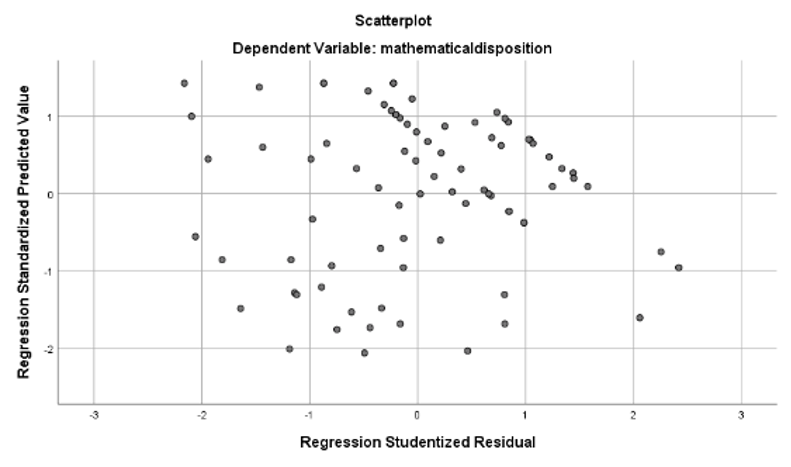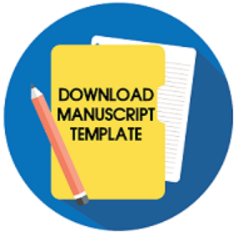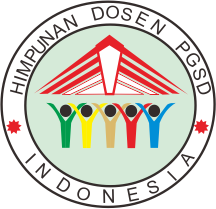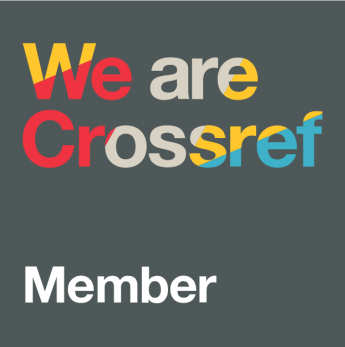How Can Learning Motivation and Problem-Solving Predict the Mathematical Disposition of Primary Students?

Downloads
This study aims to analyse the simultaneous impact of learning motivation (affective aspect) and problem-solving (cognitive aspect) on the mathematical disposition of primary students. Using a quantitative survey with a cross-sectional design, data were collected from 81 fourth-grade students through validated questionnaires and problem-solving tests. Multiple linear regression was applied after verifying the classical assumptions. The results indicated that both variables significantly affect mathematical disposition when analysed together. However, only problem-solving showed a significant partial effect. This suggests that cognitive skills are more dominant than affective factors in shaping students’ mathematical disposition. These findings highlight the importance of strengthening problem- solving skills from an early age as a foundation for developing positive attitudes toward mathematics. The study contributes to theoretical development by integrating cognitive and affective dimensions and offers practical implications for enhancing learning strategies in primary education.
Downloads
Ab, J. S., Margono, G., & Rahayu, W. (2019). The logical thinking ability: Mathematical disposition and self-regulated learning. Journal of Physics: Conference Series, 1155(1). https://doi.org/10.1088/1742-6596/1155/1/012092
Aini, H., & Khuzaini, N. (2024). The influence of mathematical disposition on high school students’ understanding of mathematical concepts. Union: Jurnal Ilmiah Pendidikan Matematika, 12(1), 96–115. https://doi.org/10.30738/union.v12i1.17023
Alim, J. A., Hermita, N., Alim, M. L., Wijaya, T. T., & Pereira, J. (2021). Developing a math textbook using realistic mathematics education approach to increase elementary students’ learning motivation. Jurnal Prima Edukasia, 9(2), 193–201. https://doi.org/10.21831/jpe.v9i2.39393
Arifin, S., Wahyudin, W., & Herman, T. (2020). The effects of contextual group guided discovery learning on students’ mathematical understanding and reasoning. Jurnal Prima Edukasia, 8(2), 106–114. https://doi.org/10.21831/jpe.v8i2.33059
Arifin, Z. (2024). Problem based blended learning model and learning motivation on critical thinking ability. European Journal of Educational & Social Sciences, 9(2), 37–48. https://doi.org/10.5281/zenodo.14563347
Arili, N. Z., Turmudi, T., & Dasari, D. (2024). The effect of learning motivation towards students’ mathematics problem-solving ability: Meta-analysis correlational study. Edu-Mat: Jurnal Pendidikan Matematika, 12(1), 1. https://doi.org/10.20527/edumat.v12i1.16556
Arnidha, Y., & Maulani, E. (2022). The effect of intrapersonal and interpersonal intelligence on mathematics learning motivation. Union: Jurnal Ilmiah Pendidikan Matematika, 10(2), 217–225. https://doi.org/10.30738/union.v10i2.12234
Atma, B. A., Azahra, F. F., Mustadi, A., & Adina, C. A. (2021). Teaching style, learning motivation, and learning achievement: Do they have significant and positive relationships? Jurnal Prima Edukasia, 9(1), 23–31. https://doi.org/10.21831/jpe.v9i1.33770
Creswell, J. W., & Creswell, J. D. (2018). Research design qualitative, quantitative, and mixed methods approaches (5th ed.). Sage Publications, Inc. https://doi.org/10.4324/9780429469237-3
Damayanti, R., & Mawardi, M. (2018). Developing of MITRA learning model of problem solving-based to solve mathematical problems in elementary school. Jurnal Prima Edukasia, 6(1), 1–10. https://doi.org/10.21831/jpe.v6i1.17238
Daryanes, F., Darmadi, D., Fikri, K., Sayuti, I., Rusandi, M. A., & Situmorang, D. D. B. (2023). The development of articulate storyline interactive learning media based on case methods to train student’s problem-solving ability. Heliyon, 9(4), e15082. https://doi.org/10.1016/j.heliyon.2023.e15082
Diponegoro, A. M., Khalil, I. A., & Prahmana, R. C. I. (2024). When religion meets mathematics: From mathematical anxiety to mathematical well-being for minority group students. Infinity Journal, 13(2), 413–440. https://doi.org/10.22460/infinity.v13i2.p413-440
Elsayed, S. A. M. (2022). The effectiveness of learning mathematics according to the STEM approach in developing the mathematical proficiency of second graders of the intermediate school. Education Research International, 2022. https://doi.org/10.1155/2022/5206476
Fadillah, I., & Wahyudin, W. (2022). Mathematical problem solving ability viewed from Students’ mathematical disposition. Formatif: Jurnal Ilmiah Pendidikan MIPA, 12(1), 47–62. https://doi.org/10.30998/formatif.v12i1.9943
Firdaus, F. M., Afianti, D., Cahya, R., & Septianingtias, A. (2022). The use of macromedia flash application in improving the mathematical understanding of elementary school students. Jurnal Prima Edukasia, 10(2), 114–122. https://doi.org/10.21831/jpe.v10i2.47427
Firdaus, F. M., Fadhilah, N., Wuryandari, I. T., & Fadhli, R. (2024). Liveworksheet interactive e-module effect on equal fractions comprehension at 4th grade elementary school. Jurnal Prima Edukasia, 12(1), 156–164. https://doi.org/10.21831/jpe.v12i1.64526
Fitriya, Y., Wulandari, R., Sumadi, C. D., & Madura, U. T. (2023). Analysis of mathematical disposition in elementary schools mathematics learning. Jurnal Cakrawala Pendas, 9(3), 475–487. https://doi.org/http://dx.doi.org/10.31949/jcp.v9i3.5127
Hamzah, A. M. (2023). Trends in international mathematics and Science Study (TIMSS) as a measurement for Student mathematics assessment development. 12 Waiheru, 9(2), 189–196. https://doi.org/10.47655/12waiheru.v9i2.144
Hayat, F., Khan, M., Ahmad, S., Kamran, M., & Maleeha. (2024). Exploring the characteristics of concrete operational stage among primary school students. Qlantic: Journal of Social Sciences and Humanities, 5(1), 124–132. https://doi.org/10.55737/qjssh.786349315
Hidayat, W., Rohaeti, E. E., Ginanjar, A., & Putri, R. I. I. (2022). An ePub learning module and students’ mathematical reasoning ability: A development study. Journal on Mathematics Education, 13(1), 103–118. https://doi.org/10.22342/jme.v13i1.pp103-118
Hollenstein, L., Rubie-Davies, C. M., & Brühwiler, C. (2024). Teacher expectations and their relations with primary school students’ achievement, self-concept, and anxiety in mathematics. Social Psychology of Education, 27(2), 567–586. https://doi.org/10.1007/s11218-023-09856-1
Hussein, Y. F., & Csíkos, C. (2023). The effect of teaching conceptual knowledge on students’ achievement, anxiety about, and attitude toward mathematics. Eurasia Journal of Mathematics, Science and Technology Education, 19(2). https://doi.org/10.29333/ejmste/12938
Hutajulu, M., Wijaya, T. T., & Hidayat, W. (2019). The effect of mathematical disposition and learning motivation on problem solving: An analysis. Infinity Journal, 8(2), 229–238. https://doi.org/10.22460/infinity.v8i2.p229-238
Hwang, S., & Son, T. (2021). Students’ attitude toward mathematics and its relationship with mathematics achievement. Journal of Education and E-Learning Research, 8(3), 272–280. https://doi.org/10.20448/JOURNAL.509.2021.83.272.280
Inram, A., & Islamiati, N. (2018). An analysis of students mathematical disposition using the Comic media in learning geometry. Proceedings of the 5th Annual International Seminar on Transformative Education and Educational Leadership (AMCA 2018), 231, 212–215. https://doi.org/10.2991/amca-18.2018.58
Irawan, S., & Iasha, V. (2021). Core learning model and mathematical disposition, against mathematics problem solving ability of elementary school students. Buana Pendidikan, 17(2), 122–129. https://doi.org/10.36456/bp.vol17.no.2.a3942
Islamiati, N., Lapele, D. A., & Sari, B. P. (2021). Mathematical problem solving ability in terms of mathematical disposition on the application of group investigation (GI) learning models. Edumatica : Jurnal Pendidikan Matematika, 11(02), 29–37. https://doi.org/10.22437/edumatica.v11i02.12205
Kamid, K., Huda, N., Syafmen, W., Sufri, S., & Sofnidar, S. (2021). The relationship between students’ mathematical disposition and their learning outcomes. Journal of Education and Learning (EduLearn), 15(3), 376–382. https://doi.org/10.11591/edulearn.v15i3.17604
Klang, N., Karlsson, N., Kilborn, W., Eriksson, P., & Karlberg, M. (2021). Mathematical problem solving through cooperative learning—the importance of peer acceptance and friendships. Frontiers in Education, 6(August), 1–10. https://doi.org/10.3389/feduc.2021.710296
Kusmaryono, I., Suyitno, H., Dwijanto, D., & Dwidayati, N. (2019). The effect of mathematical disposition on mathematical power formation: Review of dispositional mental functions. International Journal of Instruction, 12(1), 343–356. https://doi.org/10.29333/iji.2019.12123a
Kusmaryono, I., Suyitno, H., Dwijanto, D., & Dwidayati, N. (2020). Deconstruction mathematics anxiety into motivation to develop mathematical disposition. International Journal of Scientific and Technology Research, 9(4), 1923–1928. https://www.ijstr.org/
Lomri, Y. A., & Dasari, D. (2024). The correlation between mathematical disposition and problem solving in junior high school students. Mathema Journal, 6(1), 2024. https://doi.org/10.33365/jm.v6i1
Nasution, E. Y. P., Yulia, P., Anggraini, R. S., Putri, R., & Sari, M. (2021). Correlation between mathematical creative thinking ability and mathematical creative thinking disposition in geometry. Journal of Physics: Conference Series, 1778(1), 012001. https://doi.org/10.1088/1742- 6596/1778/1/012001
Nurharyanto, D. W., & Retnawati, H. (2020). The difficulties of the elementary school students in solving the mathematical narrative test items. Jurnal Prima Edukasia, 8(1), 29–39. https://doi.org/10.21831/jpe.v8i1.29969
Nurlela, S., Yuliyanto, A., Nurhasanah, S., Mulia, A. S., & Ridwan, R. M. (2025). The influence of mathematical disposition on the mathematical problem-solving ability of fifth-grade elementary school students. Proceedings of the International Conference on Elementary Education, 7(1), 886– 898. http://proceedings2.upi.edu/index.php/icee/article/view/4066
OECD. (2019). PISA 2018 results (Volume I): What students know and can do (Vol. I). https://doi.org/10.1787/5f07c754-en
OECD. (2023). PISA 2022 results: Factsheets - Indonesia. In OECD Publishing. https://www.oecd.org/en/publications/pisa-2022-results-volume-i-and-ii-country- notes_ed6fbcc5-en/indonesia_c2e1ae0e-en.html
Oktavia, T., & Yulia, P. (2024). Learning achievement: Understanding the influence of self-confidence and mathematical disposition in junior high school students. Mathline: Jurnal Matematika dan Pendidikan Matematika, 9(3), 661–674. https://doi.org/10.31943/mathline.v9i3.601
Pangestu, K., Malagola, Y., Robbaniyah, I., & Rahajeng, D. (2024). The influence of project based learning on learning outcomes, creativity and student motivation in science learning at elementary schools. Jurnal Prima Edukasia, 12(2), 194–203. https://doi.org/https://doi.org/10.21831/jpe.v12i2.63208
Sari, D. P., & Darhim. (2020). Implementation of react strategy to develop mathematical representation, reasoning, and disposition ability. Journal on Mathematics Education, 11(1), 145–156. https://doi.org/10.22342/jme.11.1.7806.145-156
Schukajlow, S., Rakoczy, K., & Pekrun, R. (2017). Emotions and motivation in mathematics education: theoretical considerations and empirical contributions. ZDM Mathematics Education, 49(3), 307– 322. https://doi.org/10.1007/s11858-017-0864-6
Sholichah, F. M., & Aini, A. N. (2022). Math anxiety of students: Levels and aspects of anxiety. Journal of Mathematics Learning Innovation, 1(2), 125–134. https://doi.org/10.35905/jmlipare.v1i2.4374
Sugianto, R., & Darmayanti, R. (2022). Stage of cognitive mathematics students development based onPiaget’s theory reviewing from personality type. Plusminus: Jurnal Pendidikan Matematika, 2(1), 17–26. https://doi.org/10.31980/plusminus.v2i1.1473
Supriadi, N., Jamaluddin Z, W., & Suherman, S. (2024). The role of learning anxiety and mathematical reasoning as predictor of promoting learning motivation: The mediating role of mathematical problem solving. Thinking Skills and Creativity, 52, 101497. https://doi.org/10.1016/j.tsc.2024.101497
Suryatin, S., & Sugiman, S. (2019). Comic book for improving the elementary school students’ mathematical problem solving skills and self-confidence. Jurnal Prima Edukasia, 7(1), 58–72. https://doi.org/10.21831/jpe.v7i1.10747
Szabo, Z. K., Körtesi, P., Guncaga, J., Szabo, D., & Neag, R. (2020). Examples of problem solving strategies in mathematics education supporting the sustainability of 21st-century skills. Sustainability (Switzerland), 12(23), 1–28. https://doi.org/10.3390/su122310113
Tampa, A., Ihsan, H., & Sulleng, O. M. (2024). Interrelationship of mathematical problem-solving ability, mathematical disposition, and gender among grade 10 students. Jurnal Matematika Kreatif-Inovatif, 15(2), 548–565. https://doi.org/https://doi.org/10.15294/zb49zs61
Tong, D. H., Uyen, B. P., & Quoc, N. V. A. (2021). The improvement of 10th students’ mathematical communication skills through learning ellipse topics. Heliyon, 7(11), e08282. https://doi.org/10.1016/j.heliyon.2021.e08282
Triwahyuningtyas, D., Sesanti, N. R., Firdayanti, E., & Aziza, N. (2022). Multiplication and division of fractions based on numerical literacy electronic module for fifth grade elementary school students. Jurnal Prima Edukasia, 10(1), 37–46. https://doi.org/10.21831/jpe.v10i1.44881
Wahyudin, W., Marzuki, M., Suryadi, D., Cahya, E., & Shofia Maulida, A. (2024). The effect of mathematical disposition on students’ mathematical performance. Proceedings of the 7th International Conference on Mathematics and Science Education (ICMScE), 2024, 587–595. https://doi.org/10.18502/kss.v9i13.15962
Wahyuningrum, E., Bonyah, E., Yumiati, Y., Kartono, K., & Wijayanti, N. (2024). Exploring the relationship between problem-solving ability and mathematical disposition in 10-11 year’s old students using model-eliciting activities. Al-Jabar: Jurnal Pendidikan Matematika, 15(02), 333– 347. https://doi.org/10.24042/ajpm.v15i2.23765
Wakhata, R., Balimuttajjo, S., & Mutarutinya, V. (2024). Relationship between students’ attitude towards, and performance in mathematics word problems. PLOS ONE, 19(2), 1–26. https://doi.org/10.1371/journal.pone.0278593
Yang, X., & Kaiser, G. (2022). The impact of mathematics teachers’ professional competence on instructional quality and students’ mathematics learning outcomes. Current Opinion in Behavioral Sciences, 48, 101225. https://doi.org/10.1016/j.cobeha.2022.101225
Yustikarinda, A. N., Widodo, S., & Katmininingsih, Y. (2024). Mathematical disposition and the impact of learning cycle 7E on problem solving skills in mathematics. International Journal of Humanities Education and Social Sciences, 4(1), 561–570. https://doi.org/10.55227/ijhess.v4i1.1121
Zuo, S., Huang, Q., & Qi, C. (2024). The relationship between cognitive activation and mathematics achievement: mediating roles of self-efficacy and mathematics anxiety. Current Psychology, 43(39), 30794–30805. https://doi.org/10.1016/j.ijer.2020.101648
Copyright (c) 2025 Jurnal Prima Edukasia

This work is licensed under a Creative Commons Attribution-ShareAlike 4.0 International License.
The copyright of the received article shall be assigned to the journal as the publisher of the journal. The intended copyright includes the right to publish the article in various forms (including reprints). The journal maintains the publishing rights to the published articles.

Jurnal Prima Edukasia by http://journal.uny.ac.id/index.php/jpe/index is licensed under a Creative Commons Attribution-ShareAlike 4.0 International License.


























